For fifteen years, I’ve been teaching yoga. In December of 2012, I did something that changed the direction of my yoga teaching in a very positive way: I took a week-long course Yoga Therapy Training: Seniors and Bone Strength at Ananda’s retreat center, The Expanding Light, near Nevada City, California. The course is part of the curriculum for Ananda’s Yoga Therapy Training program.
Primarily, I teach yoga at an active senior community near where I live in Northern California. A couple of years ago, during an Ananda Yoga Teacher’s renewal week, I learned that people with osteoporosis should not be doing any yoga postures that require them to do a forward bend with their upper spines. This was a shock to me, and I felt bad that I had been teaching forward bends wrongly to many students for 10 years, potentially harming them. So I thought that I’d better give the yoga therapy class a try.
I’d like to share with you some of what I’ve learned while teaching an older population.
Getting the Word Out
“Seniors”—Since taking the yoga therapy class, I’ve created a new class for seniors which is designed to strengthen bones, improve balance, and increase flexibility. I teach the same class, whether it is called “Yoga for Osteoporosis” or “Seniors Yoga”; the title depends on the place where I am teaching.
In the active senior community with a population of 11,000 people, all over age 55, there are exercise classes offered for people with Arthritis, Diabetes, and now Yoga for Osteoporosis. This is not the case when you are offering a yoga class to the general public in an age-diverse town or city. In the latter instance, you will need to cast a wider net, so I call that class “Yoga for Seniors” or “Seniors Yoga,” to appeal to the largest possible group of potential students.
Lesson one for anyone contemplating teaching yoga to seniors: few, if any, seniors like to think of themselves as seniors. This point was made to me when I contacted a former yoga student of mine, to let her know that I was starting a new class called “Seniors Yoga.” She is 89 years old, and her first question to me was: “Does this mean that I’m a senior?” She was serious!
The lesson really hit home when I read a press release written by the owner of a yoga studio where I teach a “Seniors Yoga” class. Now, I am only 60 years old, with two kids still in college. The article mentioned that the instructor (yours truly), was “herself a senior,” and I felt a jolt of something shoot through my chest when I read that word “senior” used to describe me! That taught me— viscerally!—how my 89-year-old student must have felt when I was trying to be so helpful.
So, tread delicately when you are getting the word out to prospective senior yoga students about a yoga class designed especially for them. I would not emphasize their age!
People with Osteoporosis
These folks, on the other hand, are usually glad to find a yoga class created just for them. They are often surprised, and then worried, when they learn from their doctors that they have osteopenia (that is, they are at risk of developing osteoporosis) or full-blown osteoporosis.
Their doctors usually want them to start taking medications to make their bones stronger, and many of them do so. However, some of them have started getting secondary symptoms (esophageal, dental) caused by those same medications, so it is problematic for them to continue taking the meds. These folks are grateful that there is a healthy alternative—a yoga class—geared specifically toward people with osteoporosis.
In fact, several students have told me that their doctors recommended that they take my yoga class, after letting them know that they are at risk for, or that they have, osteoporosis. One student asked her doctor to write her a prescription for the Osteo Yoga class, and she is able to deduct the cost of taking the class as a medical expense on her taxes.
A final word about publicizing the class: a colorful tri-fold brochure or flyer advertising the class, and explaining what it entails, is very helpful for attracting potential students. It is useful to place them in strategic locations where the target population hangs out: a local coffee shop, a Seniors center, a doctor’s office, a health club, or anywhere else that you can think of (and can get permission from the business owner) to advertise your class.
My first round of brochures was more illustrative than informative, and I think that one of the photos that I downloaded from Clip Art (of young people lying on their bellies on the floor, in Cobra pose) might have scared some people off! In the second version, the brochure was filled with bullet-points of useful scientific information, a testimonial from a physical therapist whose mother was in my class, and more user-friendly images of older people doing yoga postures.
Structuring the Class
The first thing to do, when new students come to class, is have them fill out a medical questionnaire. You can read them after class, both in the interests of time and because some students are private about their physical conditions and do not want to disclose what is “wrong” with their bodies. Also, the monthly series of classes that I teach usually begins with the students sharing what their diagnosis is, what medications they are taking/have taken, and what they are hoping to get from the class. This is an important bonding experience for everyone.
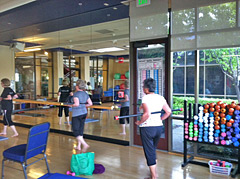 Before each class begins, students set up their places with a chair, hand weights, a sticky mat and a blanket. While the students are filtering into class, they are encouraged to walk around the perimeter of the classroom holding a weighted bar (like a shower curtain rod) behind their backs, in the crooks of their elbows. This requires them to squeeze their shoulder blades together, straightening their upper spines and lifting their chests. Plus, they chat with each other as they do the circuit—another bonding experience.
Before each class begins, students set up their places with a chair, hand weights, a sticky mat and a blanket. While the students are filtering into class, they are encouraged to walk around the perimeter of the classroom holding a weighted bar (like a shower curtain rod) behind their backs, in the crooks of their elbows. This requires them to squeeze their shoulder blades together, straightening their upper spines and lifting their chests. Plus, they chat with each other as they do the circuit—another bonding experience.
Warm Ups
We begin the class with some gentle warm-ups while standing up (often from the Energization Exercises of Paramhansa Yogananda), such as double-breathing with elbows touching, side stretches, arm circles, full yogic breath flow, or lifting and lowering the arms overhead, holding a strap.
Weights
We then sit down on the chairs and pick up hand weights for hand, wrist, and arm exercises to build bone strength and to keep the fingers and wrists flexible. Since most seniors who fall down and break a bone end up breaking their wrists or their hips, it is important to keep those parts of the body strong and supple.
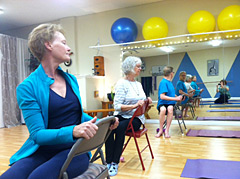 We also do marching while sitting in chairs, with the weights held where the thigh and pelvis meets, plus foot flexes and ankle rotations. We do Figure-4 Stretch (aka Eye of the Needle), Upavistha Konasana (Seated Angle Pose, not rounding the spine), gentle seated spinal twists, straight-spine forward folds, and other chair yoga postures.
We also do marching while sitting in chairs, with the weights held where the thigh and pelvis meets, plus foot flexes and ankle rotations. We do Figure-4 Stretch (aka Eye of the Needle), Upavistha Konasana (Seated Angle Pose, not rounding the spine), gentle seated spinal twists, straight-spine forward folds, and other chair yoga postures.
We do some chair yoga poses standing and holding on to the chair for stability, such as Trikonasana (Triangle Pose) and Natarajasana (King-of-the-Dance Pose). However, most standing poses are practiced at the wall or with a ballet bar, not with a chair, as the chair is too unstable.
Going to the Wall
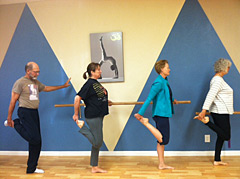 After we put the weights away and take a water break, we move over to the wall, which we use for steadiness while doing standing stretches and balance poses aimed at strengthening the bones of the legs and hips.
After we put the weights away and take a water break, we move over to the wall, which we use for steadiness while doing standing stretches and balance poses aimed at strengthening the bones of the legs and hips.
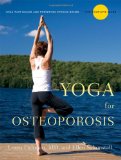
For example, from Dr. Loren Fishman’s book Yoga for Osteoporosis, we stand facing away from the wall, place squishy (half-deflated) rubber balls behind our necks and upper backs, and press the balls into the wall, holding them there for a few seconds before releasing. This strengthens the muscles that keep the upper spine upright, counteracting the tendency of this area to round forward as the bones soften.
Standing sideways, one hand on the wall, we practice side leg lifts, standing spinal twists, or balancing on one leg in Natarajasana. Some students use straps as arm extensions to lift the foot behind for a quadriceps stretch while balancing on one leg, fingers hovering near, or placed on, the wall.
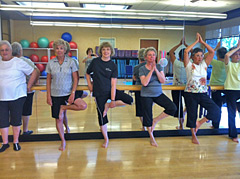 Facing the wall, we do the 90-degree angle bend, calf stretches, standing on tip-toes or rocking back on heels, and tight-rope walking from Dr. Fishman’s book—all with our hands either hovering near or resting on the wall for support.
Facing the wall, we do the 90-degree angle bend, calf stretches, standing on tip-toes or rocking back on heels, and tight-rope walking from Dr. Fishman’s book—all with our hands either hovering near or resting on the wall for support.
Standing with our backs to the wall, we practice sitting in the invisible chair, Ardha Chandrasana (Half-Moon Pose), Vrikasana (Tree Pose), and Padahastasana (Jackknife Pose). We bring the buttocks away from the wall whenever we feel stable, and lean back into the wall whenever necessary.
Coming to the Floor
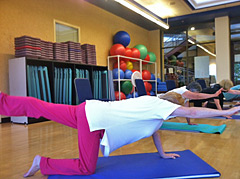 Here we do mostly weight-bearing postures. Tabletop pose (on hands and knees) is a great way to strengthen the bones by bearing weight on the arms and legs. It is also a stable position from which to stretch and balance the limbs, and it is the gateway to many weight-bearing yoga postures, such as Cat/Cow, Balancing Table (photo), Plank, Rajakapotanasana (Royal Pigeon Pose), and Adho Mukha Shvanasana (Downward Dog).
Here we do mostly weight-bearing postures. Tabletop pose (on hands and knees) is a great way to strengthen the bones by bearing weight on the arms and legs. It is also a stable position from which to stretch and balance the limbs, and it is the gateway to many weight-bearing yoga postures, such as Cat/Cow, Balancing Table (photo), Plank, Rajakapotanasana (Royal Pigeon Pose), and Adho Mukha Shvanasana (Downward Dog).
However, I recently experienced my first student injury in 15 years of teaching yoga. The woman, Vivian, now in her mid-70’s, had a hysterectomy in her 30’s and developed osteoporosis shortly thereafter. She cracked a rib, in my class while doing Cobra pose on the floor. She yelped, and said: “I think I just cracked a rib,” clutching her right side.
She knew that the rib was broken, because she had cracked several ribs over the four decades since she had developed osteoporosis and knew exactly how it felt. Sure enough, an x-ray the following day confirmed the cracked rib. I don’t know if there is anything that Vivian or I could have done to prevent the incident, and I still believe that, for most people, weight-bearing poses on the floor are safe to practice. Vivian is fine now, and she reported last week that her most recent bone density test shows that she no longer has osteoporosis, although there is still some thinning of the bones.
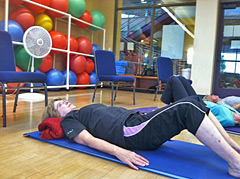 For supine poses (lying on our backs on the floor), people with excess curvature of the upper spine (kyphosis) need to use folded blankets to support their necks and heads, as the spinal curvature makes it difficult for their heads to reach the floor.
For supine poses (lying on our backs on the floor), people with excess curvature of the upper spine (kyphosis) need to use folded blankets to support their necks and heads, as the spinal curvature makes it difficult for their heads to reach the floor.
Blankets also come in handy to elevate the heads of those students who have difficulty hearing or seeing what is happening in the front of the room while they are supine. Many students also like to rest their heads on the folded blankets, or to spread the blankets over their bodies, in Savasana.
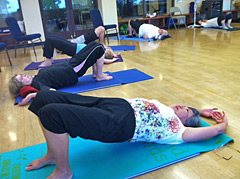 People with osteoporosis need to straighten and strengthen their upper spines. Students can do many inversions and backbends on the floor, some of which can also be weight-bearing, such as Bandhasana (Bridge Pose), Eye-of-the-Needle, Matsyasana (Fish Pose), and Jathara Parivartanasana (Supine Twist).
People with osteoporosis need to straighten and strengthen their upper spines. Students can do many inversions and backbends on the floor, some of which can also be weight-bearing, such as Bandhasana (Bridge Pose), Eye-of-the-Needle, Matsyasana (Fish Pose), and Jathara Parivartanasana (Supine Twist).
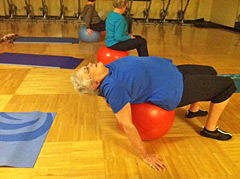 I have even taught seniors and people with osteoporosis that they can do Chakrasana (Wheel Pose) on an exercise ball. Although full of trepidation at first, they have successfully lowered themselves onto the exercise balls and experienced a version of Wheel Pose that they might never have thought they could do.
I have even taught seniors and people with osteoporosis that they can do Chakrasana (Wheel Pose) on an exercise ball. Although full of trepidation at first, they have successfully lowered themselves onto the exercise balls and experienced a version of Wheel Pose that they might never have thought they could do.
We also do some standing Wheel Pose prep when standing at the wall: Facing away from the wall, we raise our arms up overhead and place our hands on the wall behind our backs, elbows pointing up. Then we walk our feet 6-12 inches away from wall, arching the back and looking up toward the ceiling.
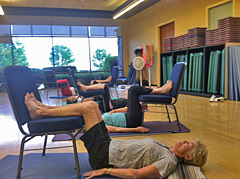 Prone postures consist mostly of backward bends, such as Sphinx, Cobra, Dhanurasana (Bow Pose), and Salabhasana (Locust Pose). Students should be guided very gently through these challenging but extremely beneficial postures—with lots of resting in-between!
Prone postures consist mostly of backward bends, such as Sphinx, Cobra, Dhanurasana (Bow Pose), and Salabhasana (Locust Pose). Students should be guided very gently through these challenging but extremely beneficial postures—with lots of resting in-between!
Some students, particularly those with spinal stenosis or scoliosis, might have been told by their doctors not to practice any backward bends at all. In such a case, you must respect the doctors’ orders, no matter what your own personal beliefs might be.
While on the floor, those who need help getting up and down from their mats keep their chairs nearby—and everyone uses a chair during a restorative Savasana at the end of the class, with the lower legs elevated comfortably on the chair seat.
Conclusion
Seniors and people with osteoporosis are eager to improve their posture, their balance, and their agility. They want to strengthen their bones without using potentially harmful medications, if possible.
I have seen—and taken photographs during class to show students—that it is possible for students to lose some roundedness in their upper spines, stand straighter and steadier, and get up and down from the floor without any help for the first time in years. Many have testified during class that, since taking the Seniors/Osteo yoga classes. they have a lot more energy and feel better physically. For sure, they feel more empowered and less helpless against the disease.
Students love handouts! I recommend that you give handouts to encourage students’ enthusiasm for taking charge of their health. For example, you can send away to the National Osteoporosis Foundation for materials, such as a chart of foods that are high in calcium.
Also, the Yoga Journal website has a helpful article about bone-strengthening yoga postures (with photos). I always show my students how those postures should be done; then I hand them a copy of the article.
Mainly, be an ally in your students’ campaign to be positive and hopeful that aging can be a great time of life. Speaking as a brand-new senior, I can attest to the fact that it is!

I would like to get this information and possibly where you teach; I am a 60 year old, teach Pilates, currently not pracicting Yoga, but was a Kundalini Yoga veteran for close to 30 yrs! was diagnosed with a point 2 osteop. in my left hip area. please send me info (possibly book titles on the topics, upcoming classes, and your own practice address, phone number). Thanks!
Sorry, Sonja – I just saw this post five years later! I teach at Auburn Yoga & Fitness in Auburn, CA. It’s 45 miles southwest of Ananda Village in Northern California. If you’d still like to chat with me about teaching “age appropriate “ yoga, my email address: susan@mountaintopyoga.com.
Thanks for sharing Susan!
I also highly recommend the Seniors & Bone Building class–it is outstanding! I’ve incorporated many of the precautions even for a regular yoga class, because half the folks over 50 have osteopenia or osteoporosis. Plus, it turns out, many of the same precautions protect healthy spines and build bone/muscle strength that we all need!
If an RYT yoga instructor (or group ex or personal trainer) wants to gain more experience to teach seniors gentle cardio and strength training, the Silver Sneakers program is a great one to take (many YMCA’s offer Silver Sneaker classes, but the training is done by a separate organization). There is the initial “classic” class (uses coordination drills w/small balls, small weights, bands, basic marching for cardio, basic stretching), and then you are also qualified to take the “chair yoga” training class as well. (I wouldn’t recommend the “circuit or cardio” training class, unless you like the heavy beat music and teaching aerobic type choreography.) The Silver Sneaker organization can help you set up classes on your own, or you can teach them at a facility such as club or gym that works with the Silver Sneaker trademark name.
As for the “senior” issue (“The soul is ageless” as Yogananda said!), a perfect solution is to take that right out of the title. At the hospital where I work, it’s called “Bone Builders Yoga.”
Thank you for sharing, Susan. I too lead Ananda-style classes for mature adults, calling them Elder Yoga, never “senior”. The word Elder designates a generation of wisdom(keepers). It is a welcomed word in our area: Western MA.
Most Ananda affirmations have become “asana and mind boosters”, all people enjoy, and ask for. The affirmations is one of the ways that set Ananda yoga apart from other styles, I could not lead without them.
I glean much useful information from the “Safe Our Bones” program, founded by Vivian Goldsmith, and suggest that we adopt her definition of osteopenia and osteoporosis. Since years she repudiates the idea that loss of bone density is a decease. (May I add: Hair loss, brittle fingernails, hardening of arteries…. they are symptoms, not deseases. And they are symptoms of life-style and environment condition. the word decease has been introduced to intimidate and create “dependency” on pharma products – ALL of which have proven to have undesirable, if not catastrophic side effects. Osteo conditions can be reversed – as is being proven – by Dr Fishman and other other bone-building experts. On Vivian’s blog are re-printable exercises that combine weight bearing with yoga.
I enjoy leading Elder yoga tremendously, and find it challenging, because my classes (at a “Senior Center”) are on drop-in basis, frequented however by “regulars” who drop in since years. Still, newcomers arrive, and cons\ditions change in peoples bodies. I sequence a class “in the moment”, depending who shows up. Classes are small, averaging 4-6 students. They each get much individual attention, and witness this individual attention, which builds community, as it were.
I regret having not kept a class journal since I began leading Elder Yoga nearly three years ago, but will do so from now on. There are so many subtleties to observe and respond to, and so many beautiful and creative ways to adapt basic asana’s.
I am grateful forever to Yogananada, for infusing this work with his wisdom, and to Swamiji’s for manifesting it in word and deed.
Hello Susan – I live in Toronto Canada and I am a certified Yoga teacher, would like to teach ONLY seniors and have just started volunteering, I am working on a website for seniors and planning on starting to teach – would greatly use any help or information you can offer. I thoroughly enjoed reading the above.
Thank you
Monda
I live in Toronto and would love to come to your class, Susan.
. Where do you teach?
Naomi: Susan teaches in Auburn, California, about an hour’s drive from The Expanding Light Retreat.
Thanks Susan,
I am certified Ananda yoga teacher and teaching yoga for the last 13 years LNRC.I have all age group students and two of my students have Osteoproses and I deal with them gentally and they feel very blessed.Your article is a great help. Blessings
Great article, thank you! I like your focus on getting the word out. Word of caution: I recently attended a class advertised as “Yoga for Bones,” and felt unwelcome by fellow students when I entered the room. I did not understand why. The teacher even singled me out and said I could leave now, just before final relaxation. I smiled and said that is my favorite part, and stayed. I finally figured out that this was a Seniors Yoga for Osteoporosis class. I am 40 and most students were maybe mid 60s; I did not think much about that because my favorite Iyengar class is mostly women in their 70s! The irony is: I have arthritis myself (since my early 30s) AND it was a great class I would gladly take again were I welcome. So, please, if you do not want younger people there, please keep “Seniors” or “Osteoporosis” in the title! It was a very uncomfortable, unhappy experience.
Susan’s reply: Thanks for your kind words. I do teach & advertise the class as “Senior Yoga,” but I would never consciously turn anyone away or make her feel unwelcome.
Good knowledge sharing from different age groups
about yoga and exercises for Seniors and older age groups.
i am keen to teach Yoga to seniors..
Your article was extremely informative and helpful. I teach dance to elders and incorporate yoga since I’m a certified yoga teacher. I plan on getting trained in chair yoga for elders. My questions are 1. Do you have your students sign waivers of liability? 2. What does your medical questionnaire consist of? Thank you again for inspiring and teaching me. Light and love, Dina
Susan writes: Yes, all students who take classes at the yoga studio where I teach are required to sign a waiver. I no longer have the people who take my “Seniors yoga” class fill out a questionnaire. Half of the students are men, and I didn’t want the class name (osteoporosis yoga) to turn anyone away. But I will send you (and anyone else who would like it) a copy of the questionnaire that I used to use when I taught the class as “osteoporosis yoga.”
This has been so helpful. I “inherited” a yoga class when I was finishing up my YTT and the students happen to be mostly Seniors. I’ve been trying to learn as much as I can, finding the book Relax into Yoga for Seniors by Carson and Krucoff helpful, as well as some chair yoga books. I just ordered the Energization booklet and poster you recommended. Any other resources?
I’d love if you could share the medical questionnaire you used to use.
I really appreciate your time!
Take care!
Thanks, Denise. Glad you found the article/blog useful. My Seniors classes are still very popular, five years after I wrote it. and they are comprised of half men and half women. That’s one reason I decided to use the word “Seniors” instead of “Bone Building” or “Osteoporosis” in the class title. Most men do not consider themselves at risk for Osteoporosis.
We now do a half hour of upper body work with hand weights, while sitting on chairs, during the first half hour. The rest of what the article describes still goes.
By separate e-mail, I am sending you the medical questionnaire that the therapeutic yoga classes hands out at Ananda’s Expanding Light.